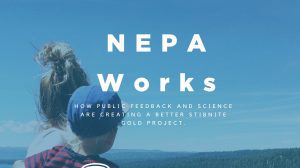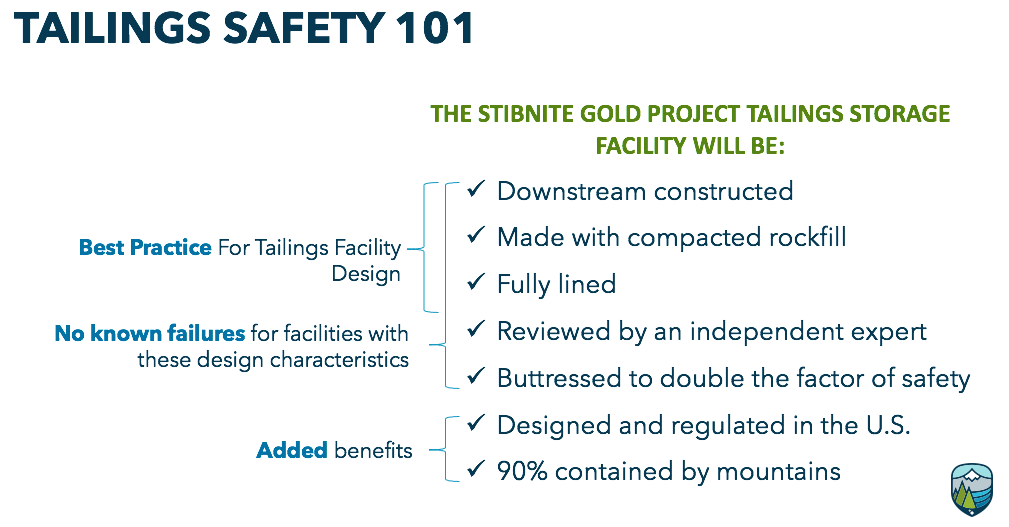Published on April 6, 2021 – Updated on February 16, 2022
“Citizens often possess helpful information about the potential environmental, social, and economic effects that proposed federal actions may have on people, places, and resources. NEPA’s requirements provide you the opportunity to provide information to a federal agency so it can take your input and unique perspective into account during the decision-making process.” – Citizen’s Guide to NEPA
When the U.S. Forest Service (USFS) released its Draft Environmental Impact Statement (DEIS) on the Stibnite Gold Project (Project) in August of 2020, it started the process for the public to review and weigh-in on our Project. Public feedback is arguably one of the most important parts of the National Environmental Policy Act (NEPA).
It is important to remember, the Draft EIS is just that – a draft intended to solicit feedback and identify areas where potential improvements can be made to improve environmental outcomes. The NEPA process is designed to apply science, incorporate public and stakeholder feedback to reduce environmental impacts and ensure only the best project moves forward in accordance with all regulatory requirements.
Nearly 10,000 individuals submitted letters on the Stibnite Gold Project DEIS. A majority of the comments were positive. However, some letters pointed out areas where the Stibnite Gold Project could be improved. The USFS is leading the process to review, respond and incorporate this feedback into the final Environmental Impact Statement (FEIS). This is the NEPA process at work.
We take all public and agency comments on our Project seriously. We diligently read each letter. After taking in this feedback, and based on our own review of the DEIS, we have identified opportunities to further improve environmental outcomes of the project without fundamentally changing the project scope. These include positive changes to water temperature, water quality and a reduction of the overall footprint of our project.
Proposed Improvements Based on Public Comments, Include:
- Reducing overall mined material by 10%
- Reducing disturbance from open pits by 7% (37 acres)
- Reducing Hangar Flats Pit by 70%
- Completely backfilling the Hangar Flats Pit, which improves overall water quality and eliminates any need for continuous water treatment.
- Reducing the project footprint by 168 acres and improve overall water quality and eliminate any need for continuous water treatment through eliminating the Fiddle Development Rock Storage Facility
- Adding additional geosynthetic covers to features on site
- Reducing water temperature maximums through additional mitigation measures , including increasing riparian vegetation and utilizing best practices
- Modifying the ore processing circuit to further improve chemistry of mine tailings to be stored in the Tailings Storage Facility.
Anticipated Outcomes Resulting from the Proposed Improvements, Include:
- 13% reduction in project footprint over original design
- 20+ miles of habitat opened for migrating fish
- 9.5% uplift in stream quality (stream functional units)
- 96% reduction in arsenic levels in Meadow Creek (below the Tailings Storage Facility) over existing conditions
- 40% reduction in arsenic levels in the East Fork South Fork of the Salmon River (below Sugar Creek) over existing conditions
- 140% uplift in wetlands quality (wetland functional units)
- 63% net increase in wetlands acres over baseline conditions
- Water temperature reduced to be at, or below, existing conditions
- 60% reduction in mercury emissions over original project design to be less than 20% of applicable EPA standards
The U.S. Forest Service is reviewing these refinements and they will determine which ones make the most sense to bring forward into the FEIS.
As the regulatory process moves forward, we want to make sure that the public has additional information regarding questions raised recently:
Was the information analyzed in the DEIS adequate?
Yes.
The DEIS was based on six years of initial data gathering and four years of regulatory review by multiple state and federal agencies, as well as additional data gathering and scientific analysis. The Draft analyzes the impacts of five separate alternatives for the mine plan and the net environmental results of those plans when combined with the required and voluntary mitigation and restoration plans proposed by Perpetua.
The US Forest Service published the DEIS when it deemed there was appropriate and adequate information to draw an accurate analysis for this stage in the process. That said, additional information will be required in this next stage of the NEPA process before the agency can select their preferred alternative in the Final Environmental Impact Statement (FEIS). The documents listed in the DEIS as unavailable were not deemed necessary for the DEIS but are required before the USFS can determine a preferred alternative in the FEIS.
Many of the items in the table relate to additional details on the modeling and design of alternatives that Perpetua Resources has already submitted. The remaining documents listed were not deemed necessary at this phase of the process. Some of these listed items can only be addressed by appropriate regulatory agencies or parties and will be required before the USFS can determine a preferred alternative in the FEIS.
You can review the studies and mitigation plans analyzed within the DEIS, including the Water Quality Management Plan discussing water treatment, here or on the USFS portal.
Is the Project on Historically Disturbed Ground?
Yes and No.
The historical Stibnite Mining District has been impacted by over 120 years of mining activity, leaving behind two open pits, millions of tons of unconstrained tailings that degrade water quality and block salmon migration. The Stibnite Gold Project is designed to leave the historical Stibnite Mining District better than it is today by keeping as much of our Project footprint in previously disturbed areas and using the resources of modern mining to provide environmental restoration.
Nearly half (45%) of the project footprint for Alternative 2 as described in the DEIS is on previously disturbed ground. And, as we mentioned earlier, we believe there are opportunities to reduce the footprint of Alternative 2 even more in the next phase of NEPA.
Beyond acre-by-acre comparisons, the project brings environmental uplift to this brownfield site. Fish will be able to migrate to historical spawning grounds and the water and habitat of the district will see dramatic improvements including uplift in wetlands, water quality and stream functional units.
Will water quality improve?
Yes.
Improving water quality over baseline conditions has been one of our goals from the very beginning and our team continues to refine the project to improve water quality outcomes. This includes incorporating best practices during construction, operations and reclamation phases to protect water quality (including water treatment), designing long-term mine features to prevent interaction of mine materials with the environment, and the removal of legacy mine waste. The DEIS found that removing legacy waste at Stibnite will improve water quality (Ch 4, p.4.12103-104of the DEIS). In fact, arsenic and antimony concentrations are predicted to decrease in stream segments adjacent to legacy mine materials (Ch 4, p. 4.9-70 of the DEIS).
Will water need to be treated forever?
No.
Analysis presented in the DEIS did indicate that water quality treatment would be needed at site forever for the Alternatives considered. The DEIS public comment period helped identify additional improvements (like removing the Fiddle Development Rock Storage Facility and elimination of the Hanger Flats pit lake) which, along with the implementation of the Water Quality Management Plan (WQMP), make it possible for the site to be self-sustaining by year 41 post-restoration, eliminating the need for water treatment forever.
Will the Project Assist Fish Populations?
Yes.
We designed our Project to help Idaho’s salmon and anadromous fish population access spawning areas that have been blocked for over 80 years and to improve habitat conditions.
When impacts from mining are combined with the offsets of mitigation and restoration, the DEIS concluded that by removing the current barriers to fish migration, our Project will assist the population of fish and add to the genetic diversity of the population – not reduce the population or its habitat. (Ch. 4 p.4.12-33 of the DEIS)
It is important to note that the way the DEIS is structured, it is possible that a reader may only review the impacts of mining activity, rather than the net outcomes of mining impacts combined with required and voluntary mitigations. This is because the analysis of both impacts and mitigation isn’t provided until Appendix D of the DEIS.
One such example is regarding loss of fish habitat. We’ve recently seen comments that the project would reduce chinook habitat by up to 26% and bull trout habitat up to 70%.
First, it is important to note that this habitat currently is unreachable to any anadromous fish and fish accessing it today are brought there through periodic trap and haul programs. So, the “loss” does not reference habitat that is accessible to fish today. One of the key components that is excluded from these numbers is the construction of the EFSFSR fishway which provides access to additional miles of stream habitat in the early years of the project.
In addition, these “loss” numbers only cite direct impacts without mitigation and restoration applied. When mitigation is added, the DEIS concludes that our Project will provide access to many more miles of stream habitat. In fact, under Alternative 2, the DEIS concludes there will be a 21.1 km (~13 mile) net gain of accessible chinook critical spawning habitat (pg. 3.12-17 of the DEIS, Table 4.12-13), resulting in potential increased population productivity.
Our project and its corresponding restoration activities will also be able to increase access to bull trout habitat. Under baseline conditions today, there is a total of 33.7 km (20.9 miles) of bull trout critical habitat in the project area (Section 4.12.2.3.6.5). Approximately 17.11 km (10.6 miles) of habitat exists upstream of the Yellow Pine pit lake and is not accessible by volitional fish passage due to the existing passage barrier at the Yellow Pine pit lake (Table 4.12-22). Under Alternatives 1, 2, and 4, an additional 17.11 km (10.6 miles) of critical habitat becomes available to bull trout as a result of construction of the East Fork of the South Fork of the Salmon River (EFSFSR) Fishway (Year -1) and removal of other fish barriers within the 17.11 km (10.6 miles) of critical habitat. Later during mining (Year 2), 4.7 km (2.9 miles) of intrinsic potential habitat is permanently lost due to diversions and the project facilities (Table 4.12-22) primarily due to the tailings storage facility/development rock storage facility. There is a long-term net gain 12.4 km (7.7 miles) of bull trout critical habitat as a result of providing volitional fish passage in Year 20.
The Project also increases the quality of that habitat (stream functional units) by 23% (Appendix D Table 8-1 Conceptual Stream and Wetland Mitigation Plan).You can read more in the Fisheries and Aquatic Resources Mitigation Plan.
Will there be large increases in Mercury in the river?
No.
There is limited naturally occurring mercury at Stibnite and mercury is not used in our gold recovery process. Mercury concentrations in surface water at Stibnite are below the most stringent water quality criterion. Most mercury in the EFSFSR watershed is downstream of Stibnite and comes from the old Cinnabar mercury mine, which is in a different tributary drainage known as Sugar Creek. There is a notable increase in mercury concentrations where Sugar Creek joins the EFSFSR today.
Conservative calculations estimate potential deposition of airborne mercury will be 0.4% or less relative to the current background deposition. In fact, predictive air quality modeling data included in Perpetua’s Agency-reviewed Air Quality Modeling Report indicates that the Project will meet all air quality standards and regulations and is well below all applicable thresholds.
Potential sources come from fugitive dust or volatilized emissions from the ore processing facility or through dust created when driving on roads. The ore processing facility for the Stibnite Gold Project is specifically designed to capture mercury that may be released in the milling processes. Reducing fugitive dust on haul roads is accomplished by treating road surfaces with water and/or sediment binders, setting appropriate speed limits for mine vehicles and monitoring dust generation with daily visual inspections to ensure the effectiveness of dust management practices.
Will mine contaminants be spread across the site?
No.
A key component of the Stibnite Gold Project is to improve existing conditions through the reprocessing and safe storage or reuse of legacy materials.
- Legacy Tailings: The Project proposes to remove, reprocess and safely store the unconstrained tailings left behind from historical mining operations. These materials will be relocated and safely stored within the Tailings Storage Facility, a completely lined and buttressed facility. The DEIS concludes this will improve water quality over existing conditions.
- Legacy Waste Rock: The Project proposes to reuse legacy waste materials, where appropriate, to help construct features such as the tailings storage facility and its buttress. Material like spent ore identified as posing a high risk of metal leaching would be placed above groundwater and underneath a liner to isolate it from interaction with water, and the buttress would ultimately have a geosynthetic cap to prevent water infiltration.
- New Tailings: New tailings produced by the Stibnite Gold Project will be processed to remove antimony and reduce risk of arsenic mobilizing in water. These tailings will then be stored in the fully-lined and buttressed tailings storage facility.
- New Development Rock: The project outlines using new development rock, rock not processed for ore value, from our own operations to backfill mine pits, which would be fully or partially covered during reclamation.
After the mine closes, will there be long term contamination of groundwater?
No.
The DEIS concludes that the removal and safe storage of legacy tailings will improve ground water. Since reviewing public comment on the DEIS, Perpetua has suggested simple modifications to the current plan that will further improve groundwater conditions, including the reduction and backfilling of the Hangar Flats pit and adding geosynthetic liners and covers to limit the potential for groundwater contamination.
Potential impacts to ground and surface water are highly regulated, monitored and controlled. Idaho regulations for the protection of groundwater require that impacts to groundwater (or connected surface waters) from mining activities may not leave the site boundary. The Idaho Department of Environmental Quality will determine protective groundwater limits and standards, establish monitoring requirements and oversee compliance.
As the Stibnite Gold Project continues its way through the NEPA permitting process we recognize that questions may arise. We want you to know we are here to listen and to provide information that may be helpful to you as you consider our Project. We value your input. We know public feedback has already helped make this project better and it will continue to do so in the future. So, let’s keep the conversation going.
If you want to reach out to our team about any topics raised here, or elsewhere, please email us at [email protected] or check out one of our webinars on a topic that interests you by visiting www.perpetuaresources.com/virtual-events.


